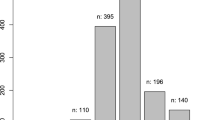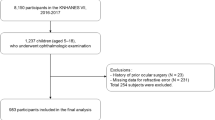Abstract
Purpose
To evaluate the sociodemographic factors of myopia and the care of myopia in Korean children.
Methods
We acquired data from 8,633 children who had completed the Health Interview Survey portion of the third Korea National Health and Nutrition Examination Survey. We assessed the prevalence of eye problems in subjects younger than 19. Sociodemographic factors that affect myopia and myopia care were identified by multivariate logistic regression analysis.
Results
The prevalence of child myopia in Korea was 22.6%. The results indicated a significant association between increasing age and myopia. There was a relation between the prevalence of myopia and income level. Participants living in homes owned by their parents or in urban areas as well as those with disabilities were more likely to have myopia. In terms of myopia care, age and monthly household income were significant factors.
Conclusions
Public education and strategies such as a national vision screening programs are needed for appropriate vision care as children get older, and more effort needs to be made in assisting disabled persons with vision care.
Similar content being viewed by others
References
Dandona R, Dandona L. Socioeconomic status and blindness. Br J Ophthalmol. 2001;85:1484–8.
Congdon NG, Friedman DS, Lietman T. Important causes of visual impairment in the world today. JAMA. 2003;290:2057–60.
Powell C, Wedner S, Richardson S. Screening for correctable visual acuity deficits in school-age children and adolescents. Cochrane Database Syst Rev. 2005;1:CD005023.
Khandekar R, Mohammed AJ. Assessment and care of children with low vision disability in Oman. Situation analysis. Saudi Med J. 2005;26:1028–30.
Lewallen S, Lowdon R, Courtright P, Mehl GL. A population-based survey of the prevalence of refractive error in Malawi. Ophthalmic Epidemiol. 1995;2:145–9.
Morgan I, Rose K. How genetic is school myopia? Prog Retin Eye Res. 2005;24:1–38.
Deaton A, Lubotsky D. Mortality, inequality and race in American cities and states. Soc Sci Med. 2003;56:1139–53.
Saw SM, Katz J, Schein OD, Chew SJ, Chan TK. Epidemiology of myopia. Epidemiol Rev. 1996;18:175–87.
Ip JM, Saw SM, Rose KA, Morgan IG, Kifley A, Wang JJ, et al. Role of near work in myopia: findings in a sample of Australian school children. Invest Ophthalmol Vis Sci. 2008;49:2903–10.
Rose KA, Morgan IG, Ip J, Kifley A, Huynh S, Smith W, et al. Outdoor activity reduces the prevalence of myopia in children. Ophthalmology. 2008;115:1279–85.
Rimmer JH, Wang E. Obesity prevalence among a group of Chicago residents with disabilities. Arch Phys Med Rehabil. 2005;86:1461–4.
Wallace RA, Schluter P. Audit of cardiovascular disease risk factors among supported adults with intellectual disability attending an ageing clinic. J Intellect Dev Disabil. 2008;33:48–58.
Park JH, Lee JS, Lee JY, Gwack J, Park JH, Kim YI, et al. Disparities between persons with and without disabilities in their participation rates in mass screening. Eur J Public Health. 2009;19:85–90.
Schulz AJ, House JS, Israel BA, Mentz G, Dvonch JT, Miranda PY, et al. Relational pathways between socioeconomic position and cardiovascular risk in a multiethnic urban sample: complexities and their implications for improving health in economically disadvantaged populations. J Epidemiol Community Health. 2008;62:638–46.
Eyler AA, Matson-Koffman D, Young DR, Wilcox S, Wilbur J, Thompson JL, et al. Quantitative study of correlates of physical activity in women from diverse racial/ethnic groups: the Women’s Cardiovascular Health Network Project—summary and conclusions. Am J Prev Med. 2003;25:93–103.
Krueger PM, Chang VW. Being poor and coping with stress: health behaviors and the risk of death. Am J Public Health. 2008;98:889–96.
Sperduto RD, Seigel D, Roberts J, Rowland M. Prevalence of myopia in the United States. Arch Ophthalmol. 1983;101:405–7.
Shimizu N, Nomura H, Ando F, Niino N, Miyake Y, Shimokata H. Refractive errors and factors associated with myopia in an adult Japanese population. Jpn J Ophthalmol. 2003;47:6–12.
He MG, Lin Z, Huang J, Lu Y, Wu CF, Xu JJ. Population-based survey of refractive error in school-aged children in Liwan District, Guangzhou. Zhonghua Yan Ke Za Zhi. 2008;44:491–6.
Czepita D, Mojsa A, Ustianowska M, Czepita M, Lachowicz E. Role of gender in the occurrence of refractive errors. Ann Acad Med Stetin. 2007;53:5–7.
Rudnicka AR, Owen CG, Richards M, Wadsworth ME, Strachan DP. Effect of breastfeeding and sociodemographic factors on visual outcome in childhood and adolescence. Am J Clin Nutr. 2008;87:1392–9.
Author information
Authors and Affiliations
Corresponding author
About this article
Cite this article
Lim, H.T., Yoon, J.S., Hwang, SS. et al. Prevalence and associated sociodemographic factors of myopia in Korean children: the 2005 third Korea National Health and Nutrition Examination Survey (KNHANES III). Jpn J Ophthalmol 56, 76–81 (2012). https://doi.org/10.1007/s10384-011-0090-7
Received:
Accepted:
Published:
Issue Date:
DOI: https://doi.org/10.1007/s10384-011-0090-7




